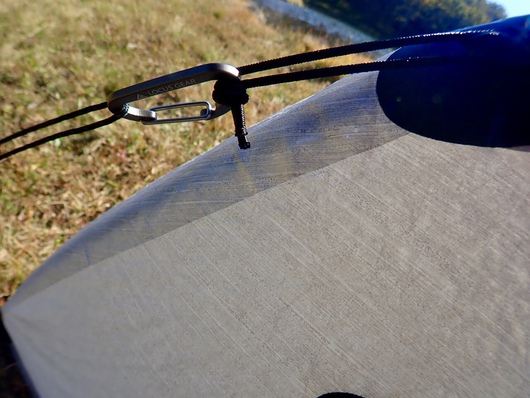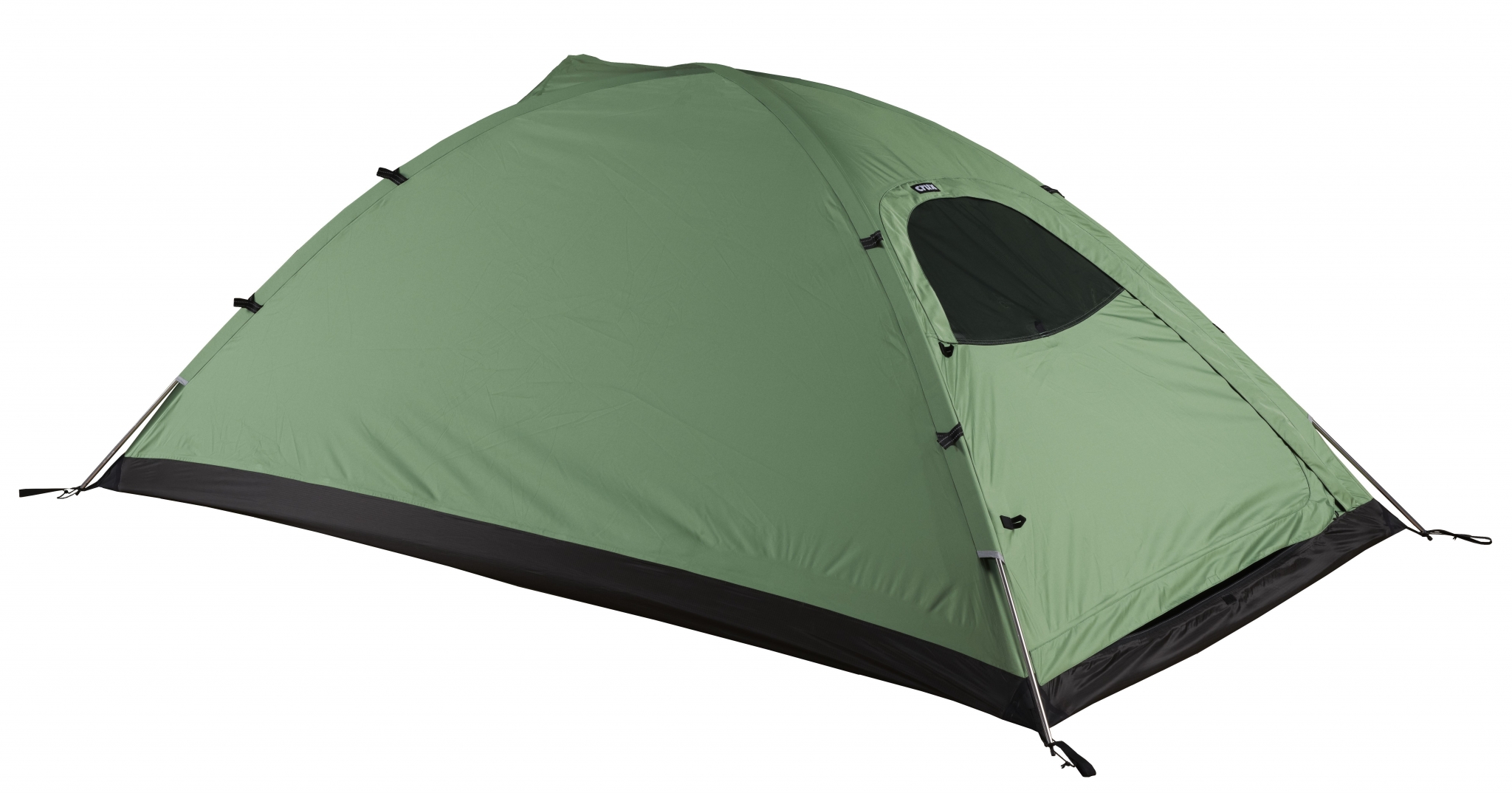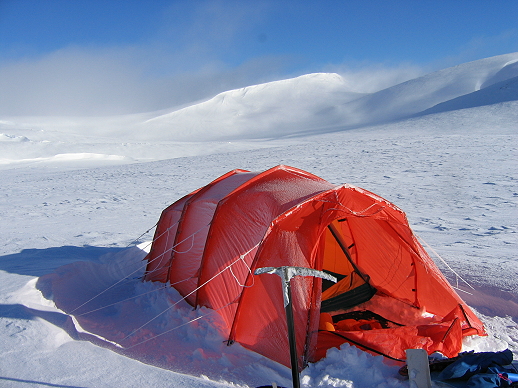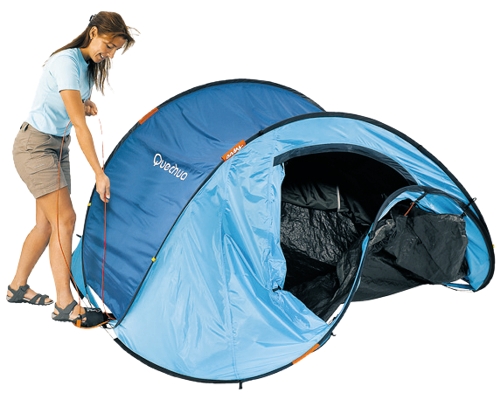Topic
"New" Locus Gear Dome Tent
Forum Posting
A Membership is required to post in the forums. Login or become a member to post in the member forums!
Home › Forums › Gear Forums › Gear (General) › "New" Locus Gear Dome Tent
- This topic has 131 replies, 5 voices, and was last updated 3 years, 5 months ago by
 Michael Harvey.
Michael Harvey.
-
AuthorPosts
-
Mar 2, 2019 at 2:59 am #3581257
The Djedi uses the common system of internal poles held in place by velcro ties, with reinforced pockets in the four corners for the pole ends.

Since the poles are carbon, condensation on the poles would be greatly reduced (a problem with alloy poles). I can’t tell if the external guyout reinforcements are linked to the velcro ties, but I would assume that is the case.
This photo shows guylines being used with mini biners and shockcord, but I don’t know if that is standard, nor whether if so it has been included in the weight.

The tent comes with a permanent vent above the front door. Here is the view from inside:

Here is the view from outside:

Of course one can crawl inside the tent during setup. That will also make it easier to set up in very strong wind. Needless to say, if conditions are really nasty, one would always have the option of using the tent without the poles as a large bivy bag, since it is made of eVent.
780 grams is pretty compelling provided the user understand the limits of the design.
And here is the sliced floor that I mentioned earlier in the thread:

Ouch!Mar 2, 2019 at 6:54 am #3581274Franco & all,
I’ve inspected but never owned a BD single wall, but have read more credible posts on BPL than I can count about having to crawl inside to set the poles in place. So I took their word for it.Another possible alternative to the Locus solo dome is in the works from Trekker Tent, located in Scotland: http://www.trekkertent.com/home/home/35-saor.html
His site says that a DCF version is in the works. It reminds me of a Hilleberg Una, a side entry, double wall two pole, one cross dome with the outer wide enough to overlap the inner and provide some storm protection for gear and getting in and out. The DCF tent will be under a kilo, so in the two pound range. There is not much on the site for specs, but quite a few photos on the silnylon version. The poles can be inserted in outer sleeves on the ground, before the tent is raised, a feature that helps in the wind. And it goes up with the inner inside (if desired), so no worries about having to throw the fly over the tent in high winds.
It is a side entry, with an interesting design for vestibule space. There is some confusion about the current and an older model in the photos at the top of the page, so it is not clear if the current model is completely free-standng. But please scroll down and look at the photos and captions, which beat any description I can provide. Note that the front entry is quite different from the rear of the tent. For those interested in this “wedge” type of self-supporting dome, this may be a good option. The owner was very good about getting right back to me with answers to inquiries about his Phreeranger update (similar to a TT Rainbow, but double wall) a while ago, so additional info is well within reach.
Hope this is of interest to domers. I’ve no affiliation, but enjoyed reading about some of his earlier prototypes that he posted on BPL. Remain a Caffin convert to modified tunnel designs like the clamshell hextent posted on MYOG, but think the Saor is a lot closer to a very light four season dome with two crossing poles than anything I’ve seen yet. The exterior pole sleeves will allow guy points in the right places.
Mar 2, 2019 at 9:25 am #3581278Errr – 4 seasons?
In sheltered lowland forest maybe. Those poles are awful long and bendy.Cheers
Mar 2, 2019 at 10:54 pm #3581380Roger, let these people know that they made the wrong choice.
Because you say so.






Note that the Bibler ITent has been around for over 40 years.
Also note that most 4 season tent manufacturers have used that design.
I hope this does not spoil your day.
Mar 2, 2019 at 11:27 pm #3581386Hi FRanco
No, it does not spoil my day at all. Hardly! :)
The design does have some good points.
* It has the smallest possible footprint for 2 people, which is a real bonus for any climbers. That is illustrated by the number of climbing photos you have listed.
* A lot of high altitude climbing is done – and HAS to be done, during the best weather. That means the tent is not TOO stressed – and if the climbers have to spend a bit of an uncomfortable or wild night hunkered down inside the tent – well, that’s fine. As evidenced by photos of the South Col, they often don’t bother bring the tent down with them anyhow, especially if it gets a bit ‘damaged’.
* It can be easy to pitch in fine weather when you are feeling a bit tired. In the remote chance the weather is bad, at that altitude you can peg the four corners out and use it as a bivy. That happens too.All that is very different from the needs of walkers who might be doing a high level traverse for a few weeks and who need somewhere to LIVE for a succession of nights after hard days, or even for a day off if the weather is stinking. In one case the ascent and the peak are everything; in the other case the walkers may be out for a few weeks for comfortable enjoyment.
Now, to suggest that most 4 season tent manufacturers have used that design is another matter. The comment does not hold any validity in Europe, Australia or New Zealand – at least for 4-season use. It may be true in North America, but I have frequently said that NA does not really have much in the way of ‘4 season tent manufacturers’ anyhow. Sadly, almost all NA mfrs are focused on the big market: 3-season fine-weather walkers. Walmart for most, and REI for a few. The marketing spin may make generous use of high-altitude photos to help glamorise the tents in the eyes of the thousands of aspiring novices, but so what? We come across such tents abandoned in the bush just a little way of a 4WD track at times. That’s how it goes.
Cheers
Mar 2, 2019 at 11:46 pm #3581387Here is Crux’s new solo dome tent in a recent-to-market wp/b fabric with an activated charcoal coating that produces a dry-touch, condensation-free inner wall (at least in conditions above freezing). I’d expect that this means the weight of the tent could increase significantly with field use as the charcoal absorbs water.

Another UK manufacturer, Lightwave, is using the same fabric in a hybrid design (extra external cross bar to match the two internal poles) with an integral porch.

I’ll leave it to others to figure out, post-Brexit, whether or not the UK counts as part of Europe.Mar 2, 2019 at 11:50 pm #3581388Regarding the Djedi’s internal pole ties, I too use Velcro wraps to hold the crossing poles of my Moment DW and SCARP 2 in place under the fly, where I have relocated them. (See Winter Hiking forum, “Winterized SCARP 2”).
Similar to the Djedi, I sewed and sealed them to the circular Hypalon reinforcement that Tarptent used for their external X-ing poles. Works very well.
Mar 3, 2019 at 12:17 am #3581394Lightwave and Crux are two brands owned and run by the same person, Carol McDermott who happens to be a New Zealand born climber.
He is the designer of those tents.
So at least one Kiwi and UK resident does design tents like that….
(just before I bought my first Tarptent I almost bought ,from Carol, one of his. That was in 2005)
Mar 3, 2019 at 12:27 am #3581399Different horse for very different racetracks. I disagree with Roger regarding American 4 season tents but the ones that work and work well are not bushwalking tents, he is right there, they are all obviously aimed at either HA base camps or summit assaults and these have different needs. HA base camps need to be strong and relatively roomy, summit tents need to be as light as possible. Simple really.
If I make it to Denali and decide I am fit enough and acclimatised enough to climb I know I will need something like a wedge tent for the high camps, but probably something with a modicum of vestibule.
Mar 3, 2019 at 12:30 am #3581401Carol McDermott who happens to be a New Zealand born climber.
And I had always blindly assumed that Carol was female. Kind of disappointing to learn that’s not the case. Thanks.
Mar 3, 2019 at 12:37 am #3581404I have often mentioned that those wedge tents are not my idea of a backpacking tent also pointing out that : yes they are designed as a high altitude compact shelter.
What I was questioning was this comment :
Errr – 4 seasons?
In sheltered lowland forest maybe. Those poles are awful long and bendy.and that ,no matter who wrote it, it’s just plain wrong.
( the reason given : awful long bendy poles indicates that he was questioning the structural integrity of the shelter not the suitability for hot/rainy weather or stuff like that)
Mar 3, 2019 at 12:52 am #3581406Here is Crux’s new solo dome tent in a recent-to-market wp/b fabric with an activated charcoal coating that produces a dry-touch, condensation-free inner wall (at least in conditions above freezing). I’d expect that this means the weight of the tent could increase significantly with field use as the charcoal absorbs water.
Now, open that door in pouring rain and see what happens.
If the ‘activated charcoal coating’ has enough thickness to do ANYthing useful, the tent will weigh a ton. Well, several kilograms at least. And the weight will rocket after field use.
Sadly, just marketing spin.I agree with Ed (AGREE??? Yep!) that they may be suitable as assault tents. My objection is that they are being sold into the novice walking market where they may be expected to protect against the rain.
awful long bendy poles indicates that he was questioning the structural integrity of the shelter
Yup, exactly. Wedge tents are little different from pop-ups in stability in wind. The poles WILL buckle and collapse. Probably quite OK in calm dry weather in the forest, but under these conditions?
This is what I call ‘4-season’ conditions: YMMV.
We need to look past all the marketing spin to actual engineering facts. Those long poles on wedges and pop-ups will not withstand high winds, and the doors will let the rain in.
Cheers
Mar 3, 2019 at 12:58 am #3581408No, you are simply wrong Roger.
There are no two pole tents stronger than that and no matter how many time you repeat your pop up analogy , you are still wrong.
Climbers over the last 30 years plus have proved the point.
Mar 3, 2019 at 1:08 am #3581409If the ‘activated charcoal coating’ has enough thickness to do ANYthing useful, the tent will weigh a ton
The X-tex fabric, as they call it, is definitely on the burly side, coming in at 75 gsm (!).
So, in the case of the Crux tent, you could get something that sells for 60% of the price of the Djedi (€579) and weighs almost twice as much (1.48 kg), while getting a much more cramped volume (85 cm headroom on the Crux).
I don’t buy the “pop up” terminology being applied here. France is a place where you do see a lot of people using real “pop-ups” (basically permanently attached self-erecting poles) in three season alpine conditions.

I’ve seen my share of trips cut short by people nonchalantly taking these up to places to which they should never go and getting flattened by comparatively gentle breezes.
Marketing spin is often accompanied by inflated prices. Yeah, we complain about the cost of DCF. But look at the way in which really flimsy tents are priced.
Mar 3, 2019 at 1:45 am #3581415What about the other “Pop-Up” wedge tent style using even longer poles as epitomised by the Moss Starlet and copied by many. Yes the poles are very long but they cross in two places and my Exped copy/clone is actually reasonably stable
Mar 3, 2019 at 1:52 am #3581416Here is a new adaptation in silnylon from a designer in Hong Kong

https://www.tarapoky.com/product/lightrock-tent/
Mar 3, 2019 at 2:04 am #3581418I imagine I have made my point well enough by now, and everyone knows what I think, so I will bow out for a while.
Cheers
Mar 3, 2019 at 2:30 am #3581420Looking over the memorial site put up by Bill Moss’s wife and business partner, Marilyn, I came across a couple of amusing links about pop-ups.
http://www.billmosstents.com/moss-blog/jay-baldwin-puts-up-a-pop-tent-in-no-time-flat
http://www.billmosstents.com/moss-blog/what-the-hell-is-a-pop-tent-2
Mar 3, 2019 at 4:18 am #3581428OK, I remember when the Quechua pop-up beach tent was released.
Giggle.Cheers
Mar 3, 2019 at 4:49 am #3581429Bill Moss designed and sold the first 1000 Pop Tents about 23 years before he designed his first hiking tent, the Stargazer

but Bill Moss did not do tunnel tents so I guess he will never be remembered as a serious tent designer.
For Jon,
I think that the Stargazer GT was the 4 season version.
The std version in 1978 was $350 , about $1350 now.
(don’t let people tell you tents were cheap way back then…)
Mar 3, 2019 at 5:06 am #3581431One of the first things that would strike anybody today is the lack of guylines on the Stargazer.
Apparently there was a four season model which had them.

This has been an awesome thread, and an awesome thread for thread drift.
I think that we kind of owe it to Locus Gear to start a new thread focused only the Djedi.
Mar 3, 2019 at 5:06 am #3581432I’m meeting with Carol (owner of Crux) next week, so I’ll ask him about the performance of his assault tents. Crux make serious kit for serious alpinists, and he’s sourced some very interesting fabrics.
Mar 3, 2019 at 5:40 am #3581436Oh Dear. I said I would be quiet, but … I suggest we need to keep a historical perspective in mind.
Just after WW II a revered Australian walker called Paddy Palin started making and selling new tents. A high-thread-count fabric using long-staple Egyptian cotton with some sort of beeswax proofing (Japara), and an A-frame design with optional side-walls. State of the art at the time (at least in Oz). Just don’t touch the fabric when it is raining! My parents bought me one around 1960, and (for Franco) I camped in it on top of Mt Feathertop in the snow once. Fairly fine weather fortunately. A big Lilo was helpful.
Would I sleep in it again? Maybe, just for the hell of it, in my backyard.
Bill Moss made a fair bit of good gear, including the Stargazer. I suggest that he was aiming at a known market, and that might have been the state of the art in that market at the time. Then the Early Winters tunnel was released, but it was aimed at a different market – and probably had a slightly different price too.
You can still buy ‘pop-ups’ of various sorts in Europe, just as you can still buy them in America. They are comfortably aimed at a large market of casual users, for whom they are probably still a good fit. A search of the Au Vieux Campeur web site https://www.auvieuxcampeur.fr/ will show you lots of these. (Warning: in French.) But for high altitude bad-weather tents, you need to go a bit beyond these. Au Vieux sells tunnels, but usually ‘on special order’. Hilleberg sells them of course – given how far north they are that is not surprising! There are other brands.
In addition, today we have silicone-coated (and Si/PU) UL nylon fabrics with respectable HH, and we have carbon fibre poles. Great improvements. But certain engineering constraints remain – or have increased. Two of them are wind strength and the weather. Design still matters.
I am unashamedly biased in my requirements: my summer and winter tents must be able to take 100 kph winds all night at 3,000 m in their stride, be very ease to pitch, be very stable in those winds (I do NOT want to spend the night holding the tent up!), offer my wife and myself decent comfort, and for my winter tent, be able to do all this in the snow at altitude as well. You have probably seen plenty of my photos.
That does NOT mean that everyone must always and only buy a tunnel tent. For a start, they are rather expensive! So in many cases my opinions and advice are really superfluous, or over the top. Fair enough.
Cheers
Mar 3, 2019 at 6:36 am #3581443Roger and all,
re: ‘Errr – 4 seasons?’
Trekker Tent markets just that one tent as a 4 season, so I’m willing to look at it that way.
re: ‘Those poles are awful long and bendy.’
Would think that could be quickly remedied by using the new Easton 6.3 carbon poles, which are the most rigid pole for their diameter I’ve seen, still lighter than alloy, and have enough flex for the Trekker Tent Saor without overstressing, assuming we can trust Easton to produce a pole that is fit for its intended purpose. They most often do.re: ‘let these people know that they made the wrong choice.’
At last I get why folks post these precipitous tent photos, but must disqualify myself, as a back fracture left me with restless leg syndrome during sleep, and I’d like to enjoy life a little longer. Nonetheless, a tent that will not hold up to high winds should be disqualified for even 3 season use, no matter where it is pitched.re: ‘Wedge tents are little different from pop-ups in stability in wind. The poles WILL buckle and collapse.’
Well for most of the simple dome tents pictured above, that may be true. However, the ones I have linked or pictured have 2 side entries and 2 vestibules that not only provide precip protection; but also, the tension from the vestibule stake points holds the poles in position and transforms the tent into a tension structure with much increased resistance to wind. It is a concept similar to the tension on fabric in tunnel tents that in conjunction with the poles, provides stability, at least lengthwise. Add guy lines attached to the base of the pole sleeves below the dome peak, and even greater structural stability can be reached.
Re: ‘Those long poles on wedges and pop-ups will not withstand high winds,’
Well, the length of the three elbow poles on Roger’s 2P tents is not that much less than the length of the pole on a solo wedge/pop-up, or 12-12.5 feet. Good poles that cross and reinforce each other should provide just as much (lateral) sideways wind resistance as a single hoop, elbowed or not, so long as the added guys are attached and positioned as mentioned above, and shown in the above photo.Re: ‘If the ‘activated charcoal coating’ has enough thickness to do ANYthing useful, the tent will weigh a ton …’
Yes, the tents shown in most of the above posts weigh well over three pounds, even if they are solo tents. That is why I posted about two solos that weigh less than 2.5 lbs. (even less when Trekker Tent markets its DCF all season tent). Submit that is what we as ultralight backpackers should be looking for.The single wall tents that claim little or no condensation raise another issue that relates to weight. For years there have been attempts to reduce weight this way. AFAIK, none of them have worked anywhere near as well as double wall tents, and given the arrival of better new tent fabrics, do not reduce weight either. Also, with a double wall that has a solid DWR inner (overhead at least), there is even less chance of being dripped upon. And for many years, BPL posts have shrugged off having to mop the inside of single walls. It doesn’t have to be that way. I NEVER have had to do that with the new fabrics going back to 2007 anyway. The perennial wisdom of house painters is that two thin coats are better than one thick one.
Re: ‘ “Pop-Up” wedge tent style using even longer poles as epitomised by the Moss Starlet’
Edward and Jon, I think that the double cross pole domes fall into a different category. They don’t require much more pole length than the single cross, but if well designed, add the greater stability that one would expect from crossing the poles twice. As often lamented, they can create a relatively flat spot at the top of the tent, where water often pools and creates leakage in pounding rain. That can be corrected by sloping the tent as with the Starlet; or by using elbows to change the hoops to gothic arches. So, some different issues, with different solutions, are presented by that design.Re: ‘so I will bow out for a while.’
Roger, it has been your ceaseless commentary that finally got me to put aside the double-cross dome issues and design for what is essentially a solo tunnel. So please don’t bow out for too long.Mar 3, 2019 at 6:46 am #3581444Hi Sam
I did make a 1-man tunnel for Ryan J many years ago. I still have the plans.

(Photo courtesy Ryan Jordan)Pole length on my TWO-man tunnels is about 2.6 m (~8′ 6″) per complete pole. That is a lot shorter than 12′! And they have a higher effective curvature too. Which explains a lot.
Cheers
-
AuthorPosts
- You must be logged in to reply to this topic.
Forum Posting
A Membership is required to post in the forums. Login or become a member to post in the member forums!
HAPPENING RIGHT NOW (February 11-21, 2025) - Shop Hyperlite Mountain Gear's Biggest Sale of the Year:
Our Community Posts are Moderated
Backpacking Light community posts are moderated and here to foster helpful and positive discussions about lightweight backpacking. Please be mindful of our values and boundaries and review our Community Guidelines prior to posting.
Get the Newsletter
Gear Research & Discovery Tools
- Browse our curated Gear Shop
- See the latest Gear Deals and Sales
- Our Recommendations
- Search for Gear on Sale with the Gear Finder
- Used Gear Swap
- Member Gear Reviews and BPL Gear Review Articles
- Browse by Gear Type or Brand.























